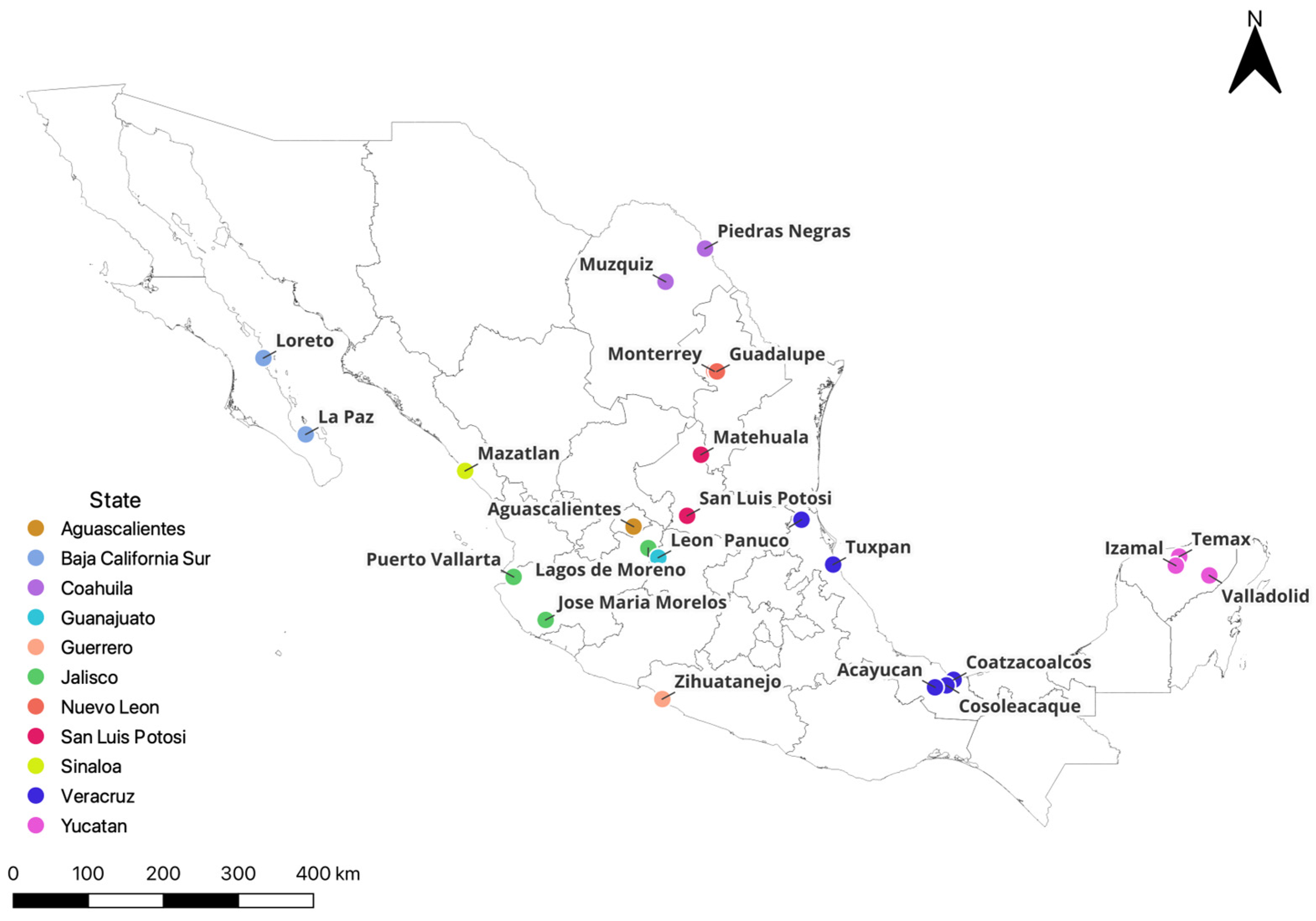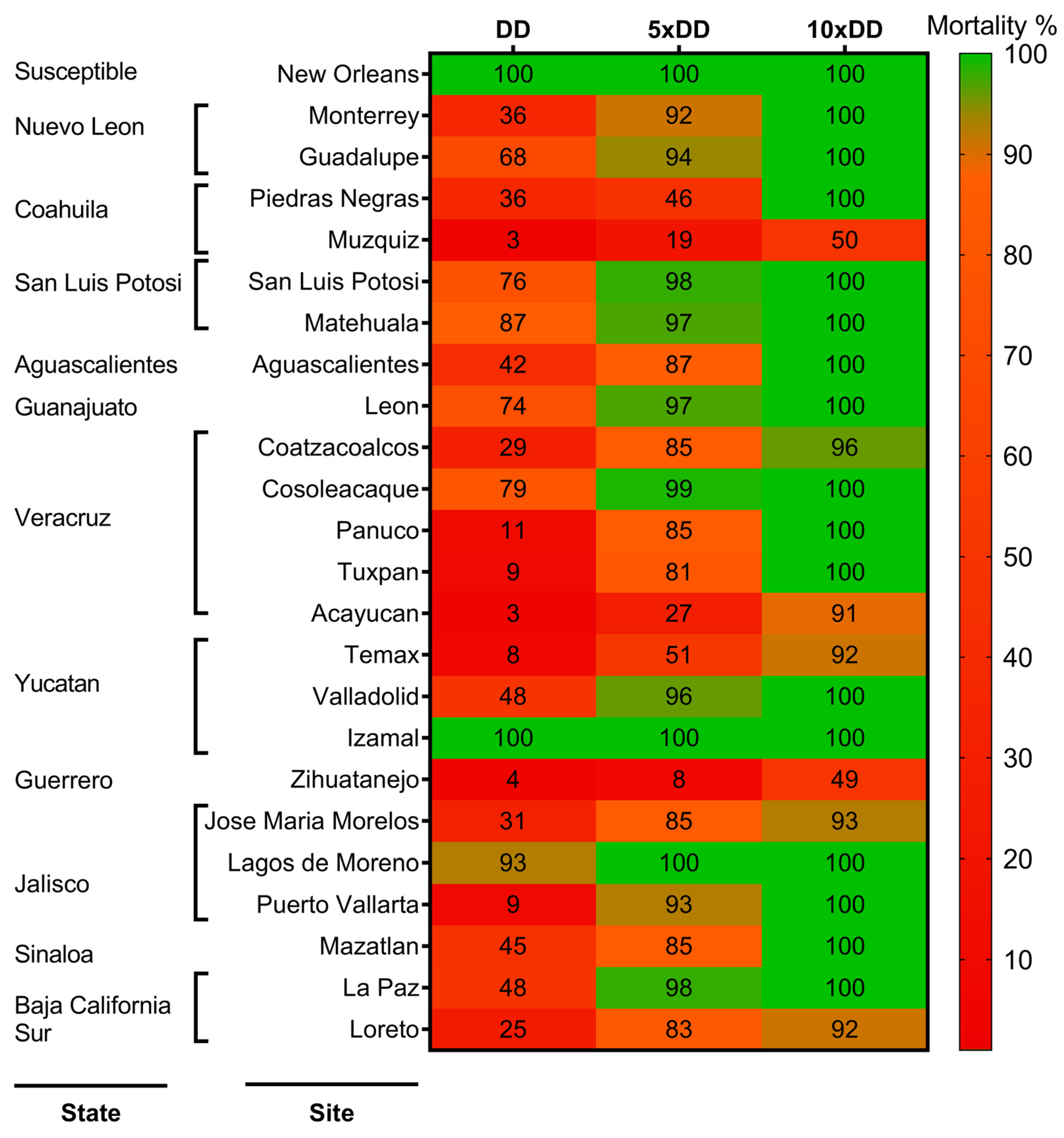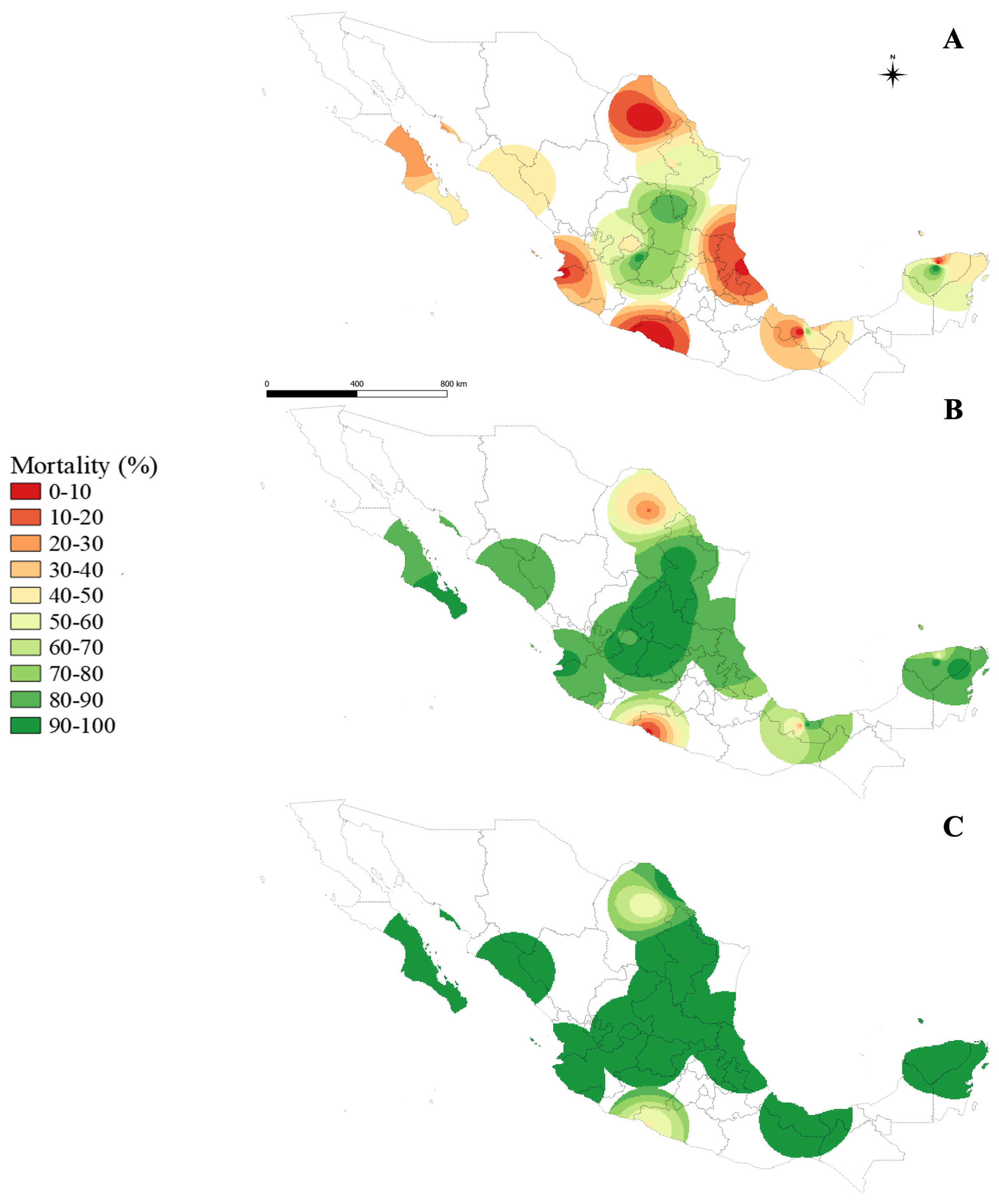Widespread Resistance to Temephos in Aedes aegypti (Diptera: Culicidae) from Mexico
Abstract
Simple Summary
Abstract
1. Introduction
2. Materials and Methods
2.1. Collection Sites and Maintenance of Colonies
2.2. Bioassays
2.3. Distribution of Resistance to Temephos
3. Results
3.1. Frequency and Intensity of Resistance to Temephos
3.2. Distribution of Resistance to Temephos
4. Discussion
5. Conclusions
Author Contributions
Funding
Data Availability Statement
Acknowledgments
Conflicts of Interest
References
- Causa, R.; Ochoa-Díaz-López, H.; Dor, A.; Rodríguez-León, F.; Solís-Hernández, R.; Pacheco-Soriano, A.L. Emerging arboviruses (dengue, chikungunya, and Zika) in Southeastern Mexico: Influence of socio-environmental determinants on knowledge and practices. Cad. Saúde Pública 2020, 36, e00110519. [Google Scholar] [CrossRef]
- DOF (Diario Oficial de la Federación). NOM-032-SSA-2-2002 Para la Vigilancia Epidemiológica, Prevención y Control de Enfermedades Transmitidas por Vectores. México. 2003. Available online: http://www.salud.gob.mx/unidades/cdi/nom/032ssa202.html (accessed on 18 February 2023).
- Centro Nacional de Programas Preventivos y Control de Enfermedades. Lista de Insumos Recomendados Para el Combate de Insectos Vectores de Enfermedades; CENAPRECE: Ciudad de México, Mexico, 2020. Available online: https://www.gob.mx/salud/cenaprece/documentos/lista-de-productos-recomendados-para-el-combate-de-insectos-vectores-a-partir-de-2023 (accessed on 2 February 2024).
- Sztankay-Gulyas, M.; Lang, F. Mosquito control with integrated method. Wiad. Parazytol. 1972, 18, 629–633. [Google Scholar]
- Chediak, M.G.; Pimenta, F., Jr.; Coelho, G.E.; Braga, I.A.; Lima, J.B.; Cavalcante, K.R.; Sousa, L.C.; Melo-Santos, M.A.; Macoris, M.L.G.; Araújo, A.P.; et al. Spatial and temporal country-wide survey of temephos resistance in Brazilian populations of Aedes aegypti. Mem. Inst. Oswaldo Cruz. 2016, 111, 311–321. [Google Scholar] [CrossRef]
- Grisales, N.; Poupardin, R.; Gomez, S.; Fonseca-Gonzalez, I.; Ranson, H.; Lenhart, A. Temephos resistance in Aedes aegypti in Colombia compromises dengue vector control. PLoS Negl. Trop. Dis. 2013, 7, e2438. [Google Scholar] [CrossRef]
- Palomino, M.; Pinto, J.; Yañez, P.; Cornelio, A.; Dias, L.; Amorim, Q.; Martins, A.J.; Lenhart, A.; Lima, J.B.P. First national-scale evaluation of temephos resistance in Aedes aegypti in Peru. Parasite Vector. 2022, 15, 1–13. [Google Scholar] [CrossRef]
- Chino-Cantor, A.; Sánchez-Arroyo, H.; Ortega-Arenas, L.D.; Castro-Hernández, E. Insecticide susceptibility of Aedes aegypti L. (Diptera: Culicidae) in Guerrero, Mexico. Southwest Entomol. 2014, 39, 601–612. [Google Scholar] [CrossRef]
- López-Solís, A.D.; Castillo-Vera, A.; Cisneros, J.; Solís-Santoyo, F.; Penilla-Navarro, R.P.; Black, W.C., IV; Torres-Estrada, J.L.; Rodríguez, A.D. Resistencia a insecticidas en Aedes aegypti y Aedes albopictus (Diptera: Culicidae) de Tapachula, Chiapas, México. Salud Publ. Mex. 2020, 62, 439–446. [Google Scholar] [CrossRef]
- Ciau-Mendoza, J.A.; Gómez-Rivera, A.S.; Canto-Mis, K.L.; Chan-Chable, R.J.; González-Acosta, C.; Moreno-García, M.; Correa-Morales, F.; Mis-Avila, P.C. Susceptibility status to temephos in larval Aedes aegypti and Aedes albopictus (Diptera: Culicidae) populations from Quintana Roo, Southeastern Mexico. Fla Entomol. 2022, 105, 255–257. [Google Scholar] [CrossRef]
- World Health Organization. Expert Committee on Vector Biology and Control. Vector Resistance to Pesticides: Fifteenth Report of the WHO Expert Committee on Vector Biology and Control [Meeting Held in Geneva from 5 to 12 March 1991]; World Health Organization: Ginebra, Switzerland, 1992; Available online: http://www.who.int/iris/handle/10665/37432 (accessed on 15 May 2019).
- Abbott, W.S.A. Method of computing the effectiveness of an insecticide. J. Econ. Entomol. 1925, 18, 265–267. [Google Scholar] [CrossRef]
- World Health Organization. Test Procedures for Insecticide Resistance Monitoring in Malaria Vector Mosquitoes, 2nd ed.; World Health Organization: Geneva, Switzerland, 2016; Available online: https://apps.who.int/iris/handle/10665/250677 (accessed on 15 May 2019).
- Gorrochotegui-Escalante, N.; Munoz, M.L.; Fernandez-Salas, I.; Beaty, B.J.; Black, W.C., 4th. Genetic isolation by distance among Aedes aegypti populations along the northeastern coast of Mexico. Am. J. Trop. Med. Hyg. 2000, 62, 200–209. [Google Scholar] [CrossRef][Green Version]
- Gorrochotegui-Escalante, N.; Gomez-Machorro, C.; Lozano-Fuentes, S.; Fernandez-Salas, L.; De Lourdes-Munoz, M.; Farfan-Ale, J.A.; Garcia-Rejon, J.; Beaty, B.J.; Black, W.C., 4th. Breeding structure of Aedes aegypti populations in Mexico varies by region. Am. J. Trop. Med. Hyg. 2002, 66, 213–222. [Google Scholar] [CrossRef]
- Wu, Y.H.; Hung, M.C. Comparison of Spatial Interpolation Techniques Using Visualization and Quantitative Assessment; InTechOpen: London, UK, 2016; pp. 17–34. [Google Scholar] [CrossRef]
- Lu, G.Y.; Wong, D.W. An adaptive inverse-distance weighting spatial interpolation technique. Comput. Geosci. 2008, 34, 1044–1055. [Google Scholar] [CrossRef]
- Marina, C.F.; Bond, J.G.; Muñoz, J.; Valle, J.; Chirino, N.; Williams, T. Spinosad: A biorational mosquito larvicide for use in car tires in southern Mexico. Parasite Vectors 2012, 5, 95. [Google Scholar] [CrossRef]
- Marina, C.F.; Bond, J.G.; Muñoz, J.; Valle, J.; Quiroz-Martínez, H.; Torres-Monzón, J.A.; Williams, T. Efficacy of larvicides for the control of dengue, Zika, and chikungunya vectors in an urban cemetery in southern Mexico. Parasitol. Res. 2018, 117, 1941–1952. [Google Scholar] [CrossRef]
- Williams, T.; Farfan, J.L.; Mercado, G.; Valle, J.; Abella, A.; Marina, C.F. Efficacy of Spinosad Granules and Lambda-Cyhalothrin Contrasts with Reduced Performance of Temephos for control of Aedes spp. in vehicle tires in Veracruz, Mexico. Insects 2019, 10, 242. [Google Scholar] [CrossRef]
- Marina, C.F.; Bond, J.G.; Muñoz, J.; Valle, J.; Quiroz-Martinez, H.; Torres-Monzon, J.A.; Williams, T. Comparison of novaluron, pyriproxyfen, spinosad and temephos as larvicides against Aedes aegypti in Chiapas, Mexico. Salud Publica Mexico 2020, 62, 424–431. [Google Scholar] [CrossRef]
- Saavedra-Rodriguez, K.; Strode, C.; Flores, A.E.; Garcia-Luna, S.; Reyes-Solis, G.; Ranson, H.; Hemingway, J.; Black, W.C., 4th. Differential transcription profiles in Aedes aegypti detoxification genes after temephos selection. Insect. Mol. Biol. 2014, 23, 199–215. [Google Scholar] [CrossRef]
- Adhikari, K.; Khanikor, B. Gradual reduction of susceptibility and enhanced detoxifying enzyme activities of laboratory reared Aedes aegypti under exposure to temephos for 28 generations. Toxicol. Rep. 2021, 8, 1883–1891. [Google Scholar] [CrossRef]
- Mazzarri, M.B.; Georghiou, G.P. Characterization of resistance to organophosphate, carbamate, and pyrethroid insecticides in field populations of Aedes aegypti from Venezuela. J. Am. Mosq. Control 1995, 11, 315–322. [Google Scholar]
- Rawlins, S.C.; Wan, J.O. Resistance in some Caribbean populations of Aedes aegypti to several insecticides. J. Am. Mosq. Control 1995, 11, 59–65. [Google Scholar]
- Rodríguez, M.M.; Bisset, J.; de Fernandez, D.M.; Lauzan, L.; Soca, A. Detection of insecticide resistance in Aedes aegypti (Diptera: Culicidae) from Cuba and Venezuela. J. Med. Entomol. 2001, 38, 623–628. [Google Scholar] [CrossRef]
- Rodriguez, M.M.; Bisset, J.; Ruiz, M.; Soca, A. Cross-resistance to pyrethroid and organophosphorus insecticides induced by selection with temephos in Aedes aegypti (Diptera: Culicidae) from Cuba. J. Med. Entomol. 2002, 39, 882–888. [Google Scholar] [CrossRef]
- Bisset, J.A.; Rodríguez, M.M.; Cáceres, L. Niveles de Resistencia a insecticidas y sus mecanismos en 2 cepas de Aedes aegypti de Panamá. Rev. Cuba. Med. Trop. 2003, 55, 191–195. [Google Scholar]
- Macoris, M.L.G.; Andrighetti, M.T.; Takaku, L.; Glasser, C.M.; Garbeloto, V.C.; Bracco, J.E. Resistance of Aedes aegypti from the state of São Paulo, Brazil, to organophosphates insecticides. Mem. Inst. Oswaldo Cruz. 2003, 98, 703–708. [Google Scholar] [CrossRef]
- Braga, I.A.; Lima, J.B.; Soares, S.d.a.S.; Valle, D. Aedes aegypti resistance to temephos during 2001 in several municipalities in the states of Rio de Janeiro, Sergipe, and Alagoas, Brazil. Mem. Inst. Oswaldo Cruz. 2004, 99, 199–203. [Google Scholar] [CrossRef]
- Lima, J.B.; Da-Cunham, M.P.; Da Silva, R.C.; Galardo, A.K.; Soares, S.D.S.; Braga, I.A.; Ramos, R.P.; Valle, D. Resistance of Aedes aegypti to organophosphates in several municipalities in the State of Rio de Janeiro and Espírito Santo, Brazil. Am. J. Trop. Med. Hyg. 2003, 68, 329–333. [Google Scholar] [CrossRef]
- Lima, E.P.; Paiva, M.H.S.; de Araujo, A.P.; da Silva, E.V.G.; da Silva, U.M.; de Oliveira, L.N.; Santana, A.E.G.; Barbosa, C.N.; Neto, C.C.D.; Goulart, M.O.F.; et al. Insecticide resistance in Aedes aegypti populations from Ceara, Brazil. Parasite Vectors 2011, 4, 5. [Google Scholar] [CrossRef]
- Beserra, E.B.; Fernandes, C.R.; de Queiroga, M.D.F.; de Castro, F.P., Jr. Resistance of Aedes aegypti (L.) (Diptera: Culicidae) populations to organophosphates temephos in the Paraiba State, Brazil. Neotrop. Entomol. 2007, 36, 303–307. [Google Scholar] [CrossRef]
- Bellinato, D.F.; Viana-Medeiros, P.F.; Araujo, S.C.; Martins, A.J.; Lima, J.B.P.; Valle, D. Resistance status to the insecticides temephos, deltamethrin, and diflubenzuron in Brazilian Aedes aegypti populations. BioMed Res. Int. 2016, 2006, 8603263. [Google Scholar] [CrossRef]
- Valle, D.; Bellinato, D.F.; Viana-Medeiros, P.F.; Lima, J.B.P.; Lima, J.B.P.; Junior, A.d.J.M. Resistance to temephos and deltamethrin in Aedes aegypti from Brazil between 1985 and 2017. Mem. Inst. Oswaldo Cruz. 2019, 114, e180544. [Google Scholar] [CrossRef]
- Bisset Lazcano, J.A.; Rodríguez, M.M.; San Martín, J.L.; Romero, J.E.; Montoya, R. Evaluación de la resistencia a insecticidas de una cepa de Aedes aegypti de El Salvador. Rev. Panam. Salud Públ. 2009, 26, 229–234. [Google Scholar] [CrossRef][Green Version]
- Marcombe, S.; Poupardin, R.; Darriet, F.; Reynaud, S.; Bonnet, J.; Strode, C.; Brengues, C.; Yebakima, A.; Ranson, H.; Corbel, V.; et al. Exploring the molecular basis of insecticide resistance in the dengue vector Aedes aegypti: A case study in Martinique Island (French West Indies). BMC Genom. 2009, 10, 494. [Google Scholar] [CrossRef]
- Llinas, G.A.; Seccacini, E.; Gardenal, C.N.; Licastro, S. Current resistance status to temephos in Aedes aegypti from different regions of Argentina. Mem. Inst. Oswaldo Cruz. 2010, 105, 113–116. [Google Scholar] [CrossRef][Green Version]
- Seccacini, E.; Lucia, A.; Zerba, E.; Licastro, S.; Masuh, H. Aedes aegypti resistance to temephos in Argentina. J. Am. Mosq. Control 2008, 24, 608–609. [Google Scholar] [CrossRef]
- Ocampo, C.B.; Salazar-Terreros, M.J.; Mina, N.J.; McAllister, J.; Brogdon, W. Insecticide resistance status of Aedes aegypti in 10 localities in Colombia. Acta Trop. 2011, 118, 37–44. [Google Scholar] [CrossRef]
- Polson, K.A.; Rawlins, S.C.; Brogdon, W.G.; Chadee, D.D. Organophosphate resistance in Trinidad and Tobago strains of Aedes aegypti. J. Am. Mosq. Control 2010, 26, 403–410. [Google Scholar] [CrossRef]
- Polson, K.A.; Brogdon, W.G.; Rawlins, S.C.; Chadee, D.D. Characterization of insecticide resistance in Trinidadian strains of Aedes aegypti mosquitoes. Acta Trop. 2011, 117, 31–38. [Google Scholar] [CrossRef]
- Bisset, J.A.; Marín, R.; Rodriguez, M.M.; Severson, D.W.; Ricardo, Y.; French, L.; Díaz, M.; Pérez, O. Insecticide resistance in two Aedes aegypti (Diptera: Culicidae) strains from Costa Rica. J. Med. Entomol. 2013, 50, 352–361. [Google Scholar] [CrossRef]
- Terán, M.C.; Rodriguez, M.M.; Ricardo, Y.; Bisset, J.A. Evaluación de temefos y pyriproxifeno en Aedes aegypti (Diptera: Culicidae) de Guayaquil, Ecuador. Rev. Cuba. Med. Trop. 2014, 66, 71–83. [Google Scholar]
- Pérez, M. Evaluación del temefos y pyriproxifeno para el control de larvas de Aedes aegypti en condiciones de laboratorio. Horiz. Med. 2017, 17, 24–29. [Google Scholar] [CrossRef]
- Jirakanjanakit, N.; Saengtharatip, S.; Rongnoparut, P.; Duchon, S.; Bellec, C.; Yoksan, S. Trend of temephos resistance in Aedes (Stegomyia) mosquitoes in Thailand during 2003–2005. Environ. Entomol. 2007, 36, 506–511. [Google Scholar] [CrossRef]
- Chen, C.D.; Nazni, W.A.; Lee, H.L.; Norma-Rashid, Y.; Lardizabal, M.L.; Sofian-Azirun, M. Temephos resistance in field Aedes (Stegomyia) albopictus (Skuse) from Selangor, Malaysia. Trop. Biomed. 2013, 30, 220–230. [Google Scholar]
- Tikar, S.N.; Kumar, A.; Prasad, G.B.; Prakash, S. Temephos-induced resistance in Aedes aegypti and its cross-resistance studies to certain insecticides from India. Parasitol. Res. 2009, 105, 57–63. [Google Scholar] [CrossRef]
- Bharati, M.; Saha, D. Insecticide resistance status and biochemical mechanisms involved in Aedes mosquitoes: A scoping review. Asian Pac. J. Trop. Med. 2021, 14, 52–63. [Google Scholar] [CrossRef]
- Alvarez, L.C.; Ponce, G.; Oviedo, M.; Lopez, B.; Flores, A.E. Susceptibility status of Aedes aegypti (L.) (Diptera: Culicidae) to temephos in Venezuela. Pest. Manag. Sci. 2014, 70, 1262–1266. [Google Scholar] [CrossRef]
- Del Rio-Galvan, S.L.; Flores, A.E.; Barrera, R.; Lopez-Monroy, B.; Felix, G.; Amador, M.; Ponce-Garcia, G. Susceptibility to temephos and spinosad in Aedes aegypti (Diptera: Culicidae) from Puerto Rico. J. Med. Entomol. 2016, 53, 1211–1217. [Google Scholar] [CrossRef]
- Maestre-Serrano, R.; Flórez-Rivadeneira, Z.; Castro-Camacho, J.M.; Ochoa-Bohórquez, L.; Gómez-Camargo, D.; Pareja-Loaiza, P.; Ponce-García, G.; Flores, A.E. Evaluation of susceptibility to organophosphates in populations of Aedes aegypti in La Guajira, Colombia. Biomedica 2023, 43, 296–304. [Google Scholar] [CrossRef]
- Rahayu, R.; Melta, D.; Hasmiwati. Detection of Ace-1 mutation in temephos-resistant Aedes aegypti L. in West Sumatra, Indonesia. Pak. J. Biol. Sci. 2022, 25, 816–821. [Google Scholar] [CrossRef]
- Manyu, S.; Elanchezhiyan, C.; Sivasankaran, K.; Basker, P. Susceptibility of Aedes albopictus (Skuse, 1894) against organophosphorus temephos, in Chidambaram, Tamil Nadu, India. Entomon 2022, 47, 383–390. [Google Scholar] [CrossRef]
- Centro Nacional de Programas Preventivos y Control de Enfermedades. Evaluación de la Eficacia Biológica de los Larvicidas y Reguladores de Crecimiento Utilizados en el Programa de Enfermedades Transmitidas por Vectores 2021: CENAPRECE 2021. Available online: https://www.gob.mx/salud/cenaprece/documentos/evaluacion-de-la-eficacia-biologica-de-larvicidas-y-reguladores-de-crecimiento-utilizados-en-el-programa-de-enfermedades-transmitidas-por-ve (accessed on 12 January 2024).
- Raghavendra, K.; Velamuri, P.S. Spinosad: A biorational mosquito larvicide for vector control. Indian J. Med. Res. 2018, 147, 4–6. [Google Scholar] [CrossRef]



Disclaimer/Publisher’s Note: The statements, opinions and data contained in all publications are solely those of the individual author(s) and contributor(s) and not of MDPI and/or the editor(s). MDPI and/or the editor(s) disclaim responsibility for any injury to people or property resulting from any ideas, methods, instructions or products referred to in the content. |
© 2024 by the authors. Licensee MDPI, Basel, Switzerland. This article is an open access article distributed under the terms and conditions of the Creative Commons Attribution (CC BY) license (https://creativecommons.org/licenses/by/4.0/).
Share and Cite
Davila-Barboza, J.A.; Gutierrez-Rodriguez, S.M.; Juache-Villagrana, A.E.; Lopez-Monroy, B.; Flores, A.E. Widespread Resistance to Temephos in Aedes aegypti (Diptera: Culicidae) from Mexico. Insects 2024, 15, 120. https://doi.org/10.3390/insects15020120
Davila-Barboza JA, Gutierrez-Rodriguez SM, Juache-Villagrana AE, Lopez-Monroy B, Flores AE. Widespread Resistance to Temephos in Aedes aegypti (Diptera: Culicidae) from Mexico. Insects. 2024; 15(2):120. https://doi.org/10.3390/insects15020120
Chicago/Turabian StyleDavila-Barboza, Jesus A., Selene M. Gutierrez-Rodriguez, Alan E. Juache-Villagrana, Beatriz Lopez-Monroy, and Adriana E. Flores. 2024. "Widespread Resistance to Temephos in Aedes aegypti (Diptera: Culicidae) from Mexico" Insects 15, no. 2: 120. https://doi.org/10.3390/insects15020120
APA StyleDavila-Barboza, J. A., Gutierrez-Rodriguez, S. M., Juache-Villagrana, A. E., Lopez-Monroy, B., & Flores, A. E. (2024). Widespread Resistance to Temephos in Aedes aegypti (Diptera: Culicidae) from Mexico. Insects, 15(2), 120. https://doi.org/10.3390/insects15020120






